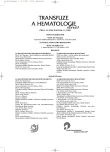-
Medical journals
- Career
Detection of minimal residual disease in acute lymphoblastic leukemia using quantification of immunoglobulin and T-cell receptor genes rearrangements. How to avoid misinterpretation of the results
Authors: E. Froňková; J. Trka
Authors‘ workplace: Laboratorní centrum Kliniky dětské hematologie a onkologie, UK 2. LF Praha ; CLIP - Childhood Leukaemia Investigation Prague
Published in: Transfuze Hematol. dnes,11, 2005, No. 3, p. 110-115.
Category: Comprehensive Reports, Original Papers, Case Reports
Overview
Currently, qualification of clonal immunoglobulin and T-cell receptor rearrangements is considered to be a standard laboratory investigation to evaluate minimal residual disease in acute lymphoblastic leukemia. Benefit of this method contributes more often to therapeutic protocols that stratify patients into the groups according to the need of differently intensive therapy or particular therapeutic regimen. Regarding complexity of the method, it is necessary to follow technical and interpretative criteria that enable reproducibility and clinical validity of the method. The authors summarize current view on design and interpretation of this modern laboratory method. They also notice possible risks when these criteria were broken.
Key words:
acute lymphoblastic leukemia, RQ-PCR, Ig/TCR rearrangements, minimal residual disease
Labels
Haematology Internal medicine Clinical oncology
Article was published inTransfusion and Haematology Today

2005 Issue 3-
All articles in this issue
- Hereditary hemochromatosis
- Benefit of the different sensitivity of aPTT reagent for diagnosis of lupus anticoagulant inhibitor
- Catalytic subunit of telomerase as a tumor antigen in multiple myeloma immunotherapy
- Detection of minimal residual disease in acute lymphoblastic leukemia using quantification of immunoglobulin and T-cell receptor genes rearrangements. How to avoid misinterpretation of the results
- LDL apheresis – evaluation of the results from 1000 performed procedures
- Blood donors satisfaction survey – public injury
- Transfusion and Haematology Today
- Journal archive
- Current issue
- Online only
- About the journal
Most read in this issue- Hereditary hemochromatosis
- Benefit of the different sensitivity of aPTT reagent for diagnosis of lupus anticoagulant inhibitor
- LDL apheresis – evaluation of the results from 1000 performed procedures
- Detection of minimal residual disease in acute lymphoblastic leukemia using quantification of immunoglobulin and T-cell receptor genes rearrangements. How to avoid misinterpretation of the results
Login#ADS_BOTTOM_SCRIPTS#Forgotten passwordEnter the email address that you registered with. We will send you instructions on how to set a new password.
- Career

